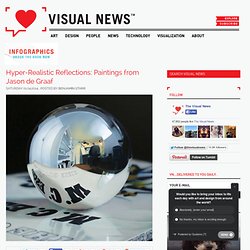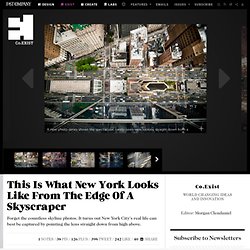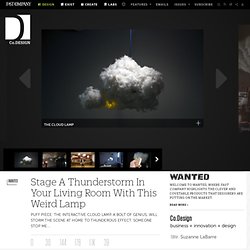

This Dozing Desk Means Never Getting Out of Bed Again. Come Take a Grand Tour of the World's Vanishing Buildings - First You See it Then You Don't. Thursday, February 27, 2014, by Amy Schellenbaum <div class="gallery loaded"><a href=" src=" lead.jpg" width="500" height="327"></a><br /><a href=" style="font-size: 9px; text-align: center;">Click here to view the full photogallery.

</a></div> As the onslaught of microhomes and isolated writers' huts can attest, often when it comes to new-found (or rediscovered) architectural tropes, what starts as a trickle of innovators quickly turns into a flood of LEDs and raw concrete. Peek Inside The World’s Forbidden Subway Tunnels. It’s hard not to be obsessed by the parts of a city most law-abiding citizens never see: views from the top of its tallest towers and inside its underground tunnels.

In New York–based artist Logan Hicks’s latest photography series, we get a glimpse at the latter, an underground world typically only visited by graffiti artists and transit workers. Though his main work involves stencil painting, rather than photography, Hicks loves exploring urban infrastructure, taking a peek into what makes a city tick. The AOL Of China To Build A Suburban Tech Campus In The Sky.
When Chinese Internet giant Tencent began looking to build a new headquarters, representatives from the company examined corporate campuses all over the world.

They were attracted to the collegiate, outdoor atmosphere of the traditional American suburban tech campus, with low-rise buildings connected across sprawling grounds. Yet the company's urban location--in Shenzhen, one of the fastest growing cities in China--made a vast Googleplex impossible. Architects from NBBJ, the global design and architecture firm behind Amazon's forthcoming bubbly biosphere in downtown Seattle as well as corporate headquarters all over the world, suggested an alternative: What if they could take the notion of the campus, and make it vertical?
Urbanization and the rise of the vertical tech campus We live in a rapidly urbanizing world. Hyper-Realistic Reflections: Paintings from Jason de Graaf. To see one of Jason de Graaf’s paintings is to be tricked into believing they are real.

His hyper-realistic worlds are painstaking illusions, created with his delicate brush strokes and resulting in the appearance of a high definition photograph. Much of his work revolves around reflection: from shiny metal orbs, to polished crystal skulls; each of his images is unbelievably real. “My paintings are about staging an alternate reality, an illusion of verisimilitude on the painted surface. I try to use objects as a vehicle to express myself, tell a story or least hint at something beyond what is actually painted.
Therefore I try to choose objects that have meaning to me or are artifacts from my life.” 16 Of The Year's Coolest Houses (And One Really Ugly One) MIT Engineers Invent A Cameraless Tracking System That Sees Through Walls. In the Iron Man movies, Tony Stark never has to worry about interacting with JARVIS, the artificial intelligence in his "smart home," by making sure that he stays in proper view of a motion-tracking camera.
He just walks anywhere he damn well pleases, barks orders and waves his hands, and JARVIS is somehow able to track him. MIT Engineers Invent A Cameraless Tracking System That Sees Through Walls. Incredible Photos From An Urban Explorer's Journeys To The Forbidden Parts Of The City. This Is What New York Looks Like From The Edge Of A Skyscraper. Superheroes and window washers aside, most New Yorkers don't spend much time leaning off rooftops 50 stories above the ground.

But the view straight down is fairly spectacular. It's a side of the city most people never see in quite this way, which is one of the reasons Navid Baraty's series of photos ended up on the walls of the Bowling Green subway station as part of the MTA’s Arts for Transit program. Baraty found the inspiration for the photos 6,000 miles away, while having lunch in a skyscraper in Tokyo. “I looked straight down and saw an amazing geometric pattern on the Tokyo street scene,” he says.
Stage A Thunderstorm In Your Living Room With This Weird Lamp. Happy Black Friday!

You Won't Believe These Shots Of Snowflakes Were Taken With An Ordinary Cam. Snowflakes teach us many lessons when we're children.

It teaches us about the fractal beauty that lies beneath all things; it teaches us about uniqueness, patterns, and infinity. But for some reason, we forget the secret beauty of the snowflake. The A-To-Zaha List: 7 Of Hadid's Best Buildings. A Beautiful, Unbreakable French Press. You don’t have to be a coffee snob to know that French presses are delicate.

Anyone who’s ever so much as picked up one of the java brewers knows that the glass beakers are incredibly, almost uncomfortably, thin. The Winners Of Our 2013 Innovation Design Award. Winning isn’t everything, but it’s certainly a perk.

Today, Fast Company threw its first-ever Innovation By Design Conference, held in downtown New York. It culminated this evening at the Innovation By Design Awards celebration, where the nine winners were revealed. Over the past several months, 1,200 entrants submitted their products, concepts, and apps. We narrowed the list down to a mere 54 finalists, and with the help of our esteemed panel of judges, we crowned the winners--forming a particularly diverse group that includes students and startups, old media and new technologies, all connected through the common thread of innovative design. Watch Our Planet's Impending Climate Disaster Unfold From Space. In case you didn’t get a chance to page through the latest IPCC report on climate change--a mind-bogglingly detailed review of scientific studies that crashed my computer when I tried to open it--this video can help catch you up on the future of our planet.
The facts are grim. By 2050, if humans keep doing what we’re doing now, the global temperature will rise more than two degrees Celsius above what it’s been for most of human history. A Staircase With A Built-In Library, Garden, And Meeting Rooms, Too. In a typical office building, stairs tend to be strictly utilitarian: a way to get up and down and nothing more.
When they’re windowless, cement-walled, and fluorescently lit, it’s not surprising that people end up taking the elevator. But more architects are starting to pay more attention to staircases, whether it’s to deliberately encourage people to exercise, as in the Bullitt Center’s “irresistible stairway” in Seattle, or as a place to socialize, as in this new project in London. Designed for a new office development in Soho, London, the “Living Staircase” has hidden rooms at each landing.